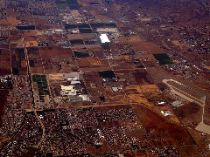
Hi there, I’m back and happy to see that artblog was such a hellzapoppin place in my absence. Thanks to everybody who contributed to the discussion about LINC and to everybody who contributed a post.
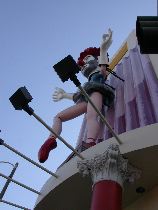
Meanwhile, I’m organizing my thoughts about my trip west into several posts and will try to keep them semi-short and at least semi-coherent. Mostly you can find commentary everywhere about California and I won’t try to add to the din. But I have a bunch of pictures to share and a few thought bubbles.
This post will deal with our time in Los Angeles, where Steve, Stella and I saw the Getty Center, had a couple of ad hoc art sitings in Santa Monica/Venice Beach, and saw the La Brea tar pits. (Note: many of my photos can be seen in medium and high resolution on my flickr site.) (this image is Jonathan Borofsky‘s “Clown Ballerina” which we stumbled upon while walking back to our hotel in Santa Monica one afternoon. Stella: “That’s pretty scary.” Me: “Yes, isn’t it great.”)
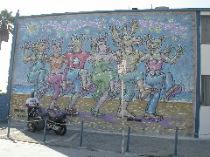
I love this mural by someone named R. Cronk on the side of a Venice Beach building. The keep on truckin ambiance coupled with the druggy I’m seeing double affect is perfect for the beach crowd we’d just left behind.
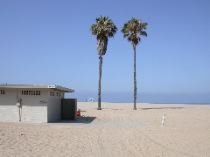
Speaking of the beach this is a shot of the Santa Monica beach which seems to go on for scores of miles. I’ve never seen so much white sand.
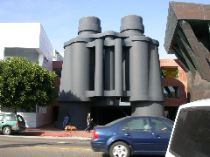
Here is the Claes Oldenburg binoculars sculpture on Main St. in either Santa Monica or Venice Beach. artblog contributor James Rosenthal mentioned them in his post a while back when he took a trip to LA. The sculpture sits outside an advertising agency about a block away from the building with the Borofsky Clown Ballerina. The latter building by the way is empty and totally forlorn giving the Clown Ballerina even more creep show edge.
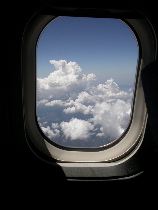
Before we get to the Getty here’s a couple of sky images from the airplane. I can’t seem to get enough of the clouds and atmosphere seen from up high so I guess you’ll have to bear with me…or cry uncle and let me know “no more clouds!”
(image at top of post is another airplane shot, taken by Stella. It’s above Los Angeles before we were landing.)

That’s Stella’s hand in silhouette and her mirror reflecting the sky in this image. I swear I wasn’t aiming fror the sky mirror sky triad. It just happened.
Getty frames the blue
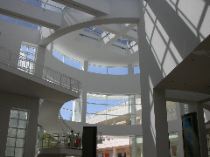
Richard Meier‘s buildings, Robert Irwin‘s gardens and the changing special exhibitions are the reason to go. Meier’s design blends inside and outside to create great outdoor rooms and inside spaces that are not bad as well. But it’s the outdoors that made the trip. Everywhere, grand promenades and lookouts give the feel of strolling the deck of a yacht or maybe walking around a palace. America’s Versailles, perhaps? The space is gracious and yet human in scale. And being up there at what seems like the top of the mountain makes you feel elevated in spirit. (image is a shot of the lobby of the main building)
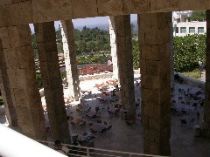
The special exhibits up now are Rembrandt’s late portraits of his friends depicted as saints. I wasn’t allowed to take photographs but I’ll just say that the way the exhibit was laid out was excellent. Ample space for each work and the exhibit set in several large, high-ceilinged rooms. A dramatic entryway was wallpapered in black with blown-up images of the Rembrandt works. You could see each brush stroke and crack and that was pretty remarkable. The curatorial gist of the show is that Rembrandt changed his painting style at the end and was a brushy expressionist in comparison with work he did as a younger man. (image is looking down on the cafeteria, a great pillared space that was unexpected for being a room outdoors.)
The other special exhibit right now is photographs by Paul Strand known to me at any rate as a New York photographer depicting the city’s architecture and people. It’s a big show and I learned that Strand worked for the WPA and that he became an expatriot during the McCarthy era in the 1950s and took his camera with him to Europe where he went back to nature and to small town life looking for authenticity. Many shots of humble working folk — fishermen, farmers, etc. Beautiful black and white photos.
In the Getty Garden
We took the garden tour at 12:30 and the white travertine stone of the buildings is positively blinding in the midday sun. In fact the Getty provides sun umbrellas for use when strolling between buildings. We used them.
Our Belgian-born docent guide, Betty Hyatt (“je parle francais, ik spreck nederlands” was her museum badge’s subtitle.) gave a sparky tour peppered with gossipy commentary about Meier and Irwin and how they disliked each other.
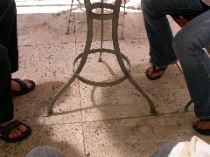
Hyatt also gives the architecture tours, so she started out with some background on the building, which was great, because apart from absorbing the brilliance of the stone and the elegance of the spaces I didn’t know much.
So, for example, apparently Meier’s design is based on the square. To be precise, the 30″ by 30″ square which is the amount of breathing space a human being needs to stand comfortably anywhere. So says pop psychology at any rate. The walls of the buildings are all segmented into patterns that are grids of 30″ by 30″ squares and the grid motif repeats everywhere. (Here’s the grid under a three-legged table in one of the outdoor rooms. Steve is fascinated with 3-legged tables (apparently they’re more stable than four-legged tables). So here’s a shot I call three legs, four feet.)
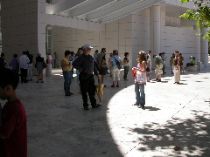
Laurie Olin was the landscape architect for the project. That’s Philadelphia’s Laurie Olin. Hit the Olin link here and it tells you of their participation in the Getty.
The trees, and there are lots, were grown in containers and planted in the very same containers on site. The containers hold 8 ft. of dirt. They’re enormous. The guide said “It’s almost like bansai. Not every tree does well but most seem to be taking it very well.”
The gardeners take no prisoners. If a tree, shrub or flower doesn’t look good, out it goes. Most of the flowers planted around the buildings are white. There are white crepe myrtls, white jasmine, white hibiscus, white wisteria. The white and the dictum for visual perfection come from Meier. There’s one flower that’s not white — the bird of paradise. But that’s ok because the flower is the official Los Angeles city flower and Meier wanted to acknowledge the city in his plan. (Indeed the city feels so far away it’s like another country so Meier is right to assert its presence with the flower.)
The buildings have now been open 8 years and apparently the design has been tweaked here and there. Here’s one example she gave. A small river-like water element, once at foot level, has now been moved up onto a waist-high wall. “It’s better now than the original,” said Hyatt, explainint that people used to step in the water when it was lying there right at foot level. “So Meier’s not as perfect as he thinks he is,” she added.
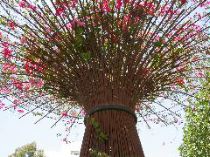
According to Hyatt, Meier was upset when he didn’t get the Getty garden commission and Robert Irwin got it instead. And you can see the prickliness of the relationship between them in a video, “Concert of Wills” in which the two sit at a round table and “discuss” the project. They didn’t like each other but they had to work together, said Hyatt.
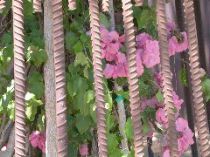
Irwin, a San Diego artist originally didn’t want there to be a guided tour of his garden because he said then people would think his work was a garden. Irwin says it’s not a garden. It’s a sculpture in the form of a garden aspiring to a work of art. That’s silly, though. It’s a garden.
Irwin didn’t know a thing about gardening, nor did he care. He had color and texture and sound ideas and he drove the gardener crazy according to Hyatt. Like with all gardens, some things work and some don’t. The bougainvillea which Irwin envisioned as fountain-like sprays tumbling over the top of four giant hourglass structure weren’t doing too well until recently. The support structures, made of rebar which seemed welded together didn’t allow enough air to circulate for the plants to thrive. (the above two pictures show the flowers and the rebar structure)
They drilled holes into the rebar supports and now the flowers are doing better. But because of the strong ocean winds the delicate flowers will never trail over the sides as Irwin hoped. (They’d be blown away or look mighty straggly if left to do so). So they’ll be trimmed to stay on top of the structures. And the whole thing, instead of looking like fountains, now suggests torches according to Hyatt.
That’s it for Getty, except to say that the tram we took to get from the parking lot to the Center is a class act. And that traffic on HY 101 when we left the building at 3 pm on a Friday afternoon was the pits — it was parking lot no matter which way you were going.
Tar baby
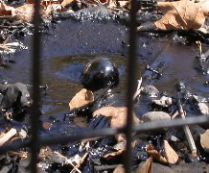
After the Getty there was only one “right” place for us. And that was the La Brea tar pits. So we drove up Wilshire Blvd, through Beverly Hills, past Rodeo Drive and into the neighborhood that houses the phenom where we parked and then asked, because it wasn’t specified in the guide book, where in the heck were they? The parking lot attendant shrugged and muttered something about they were everwhere which left us all the more confused. But indeed he was right. The park behind LA County Museum of Art, which is where the tar is, sits on a big smelly deposit that bubbles up here and there and so the tar pools are literally everywhere. And just in case you wondered, it smells like roofing material or asphalt.
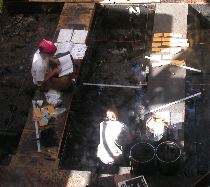
Mostly the pits have been excavated andare closed but there is one working pit and even though it was after 4 pm, the official pit closing time, a volunteer worker kindly let us in to the public observation room when she found out we were from out of town. There we got to see two young workers sitting on scaffolding over the tar, one of them leaning over as if scooping something out of the goo. The pit is sealed off from the rest of the world by a plexiglas enclosure, so nobody but authorized personnel are let inside. There’s a chalk board on one wall detailing the date and name of all the bones found. I didn’t copy down any details but clearly it’s a serious archeological site.
End of LA Story. Next I want to tell you about my San Francisco day including a studio visit with Anna Conti, artist and blogger extraordinaire. We had fun. Talked deep thoughts and a lot of hooey about art and life in San Francisco and it was a thrill to meet in the real world someone whose voice you only know in its cyber incarnation. More on that very soon.









